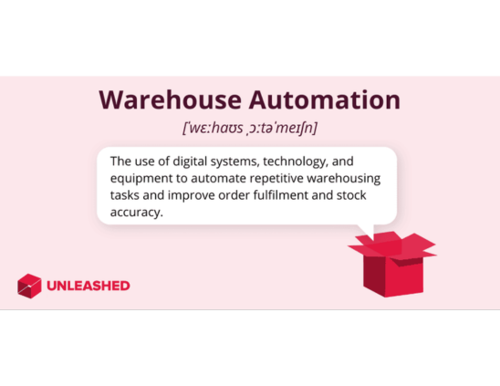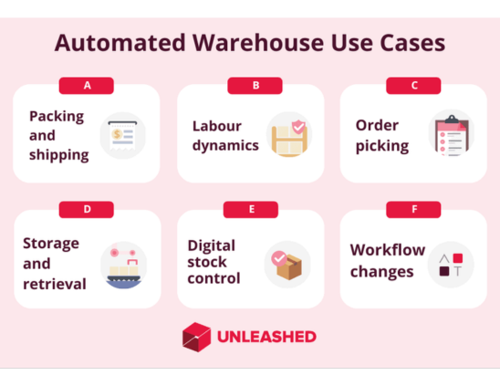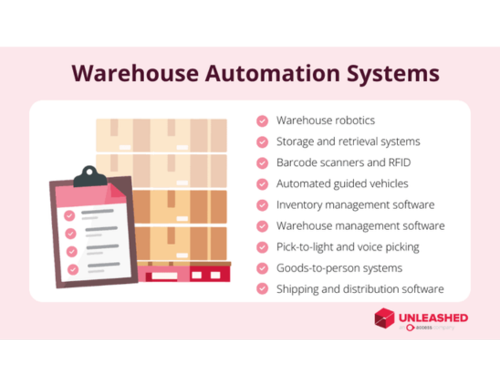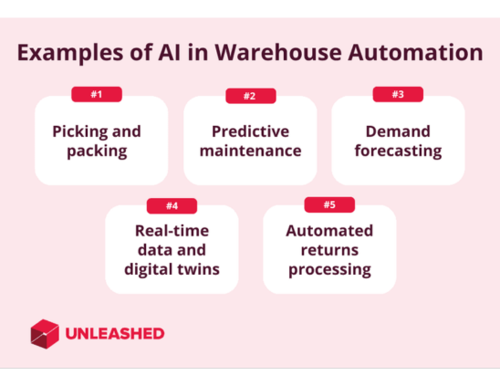
What is warehouse automation?
Warehouse automation is the use of technology, equipment, and digital systems to automate repetitive warehousing tasks and increase warehouse efficiency. By minimising laborious activities, warehouse automation saves companies time and money while empowering workers to be more productive in their roles.
There are two common applications of warehouse automation:
- Physical automation: Manual labour tasks like sorting, picking, packing, and inventory management can be automated by technologies such as warehouse robots, conveyor belts, barcode scanners, and automated storage and retrieval systems (ASRS).
- Digital automation: Data management tasks like inventory accounting, customer relationship management, and order processing can be automated by on-premises or cloud-based software solutions such as warehouse inventory management.
Each of these types of warehouse automation enables companies to work faster, reduce errors, and scale operations.

6 key advantages of automated warehouses
The main advantages of automating a warehouse include:
- Increases efficiency
- Reduces labour costs
- Enhances inventory and order accuracy
- Improves warehouse safety
- Optimises warehouse space utilisation
- Allows monitoring of data insights
1. Increased warehouse efficiency
A recent report from Deloitte revealed that companies that implemented automated systems experienced an average productivity increase of 30%.
Warehouse automation streamlines key warehousing processes, such as order picking and inventory control, leading to faster and more consistent performance. These efficiency gains help boost overall productivity.
2. Reduced labour costs
With machines and robots handling repetitive and labour-intensive tasks, the need for a large human workforce is reduced, leading to lower labour expenses.
This makes warehouse automation particularly important when considered alongside the skilled worker shortage that currently exists across the industry.
3. Enhanced inventory and order accuracy
Automated warehouse systems can reduce errors in inventory management and order processing by cutting out the risk of human miscalculations. Higher order and inventory accuracy rates lead to more satisfied customers and help prevent inventory shrinkage.
Automated warehouses can achieve order accuracy rates of over 99.9%, compared to the industry average of 97% for manual warehouses.
4. Safer warehouses
Warehouse automation can be applied to dangerous tasks, reducing the risk of workplace injuries and accidents with robotic systems and better equipment.
Risk management can also be assessed and monitored through automated warehouse systems. This helps warehouse managers identify areas or processes that need to be improved to reduce workplace injuries.
5. Optimise warehouse space utilisation
Automated systems can help you optimise the layout and storage within a warehouse, making better use of available space and allowing for higher-density storage solutions. This allows you to store more products and reduce inventory carrying costs.
6. Monitor critical warehouse insights
Automated warehouse systems often come with integrated data analytics capabilities, providing real-time insights into operations. These can help you make informed decisions around storage, sales, and marketing, and identify which processes need improving.
How an automated warehouse works
An automated warehouse employs advanced technologies to perform tasks traditionally done by humans. These tasks include:

Inventory management
In an automated warehouse, inventory management starts with the arrival of goods. Automated systems like conveyors and robotic arms handle the unloading of goods from trucks. Barcode scanners or RFID readers automatically log these items into the warehouse management system (WMS), ensuring real-time tracking and precise inventory control.
Storage and retrieval
Automated Storage and Retrieval Systems (AS/RS) are used to store items in designated locations within the warehouse. These systems use computer-controlled mechanisms to place and retrieve items from storage racks efficiently.
Order picking
Order picking, one of the most labour-intensive tasks in traditional warehouses, is revolutionised through automation. Robots or automated guided vehicles (AGVs) navigate the warehouse to pick items according to orders received by the WMS.
For example, Ocado, an online grocery retailer in the UK, uses a swarm of robots to pick items from a grid-like storage system, dramatically increasing the speed and accuracy of order fulfilment.
Packing and shipping
Once items are picked, they are transported to automated packing stations where machines handle the packing and labelling of products. Automated conveyor systems then sort and direct packages to the appropriate shipping docks.
Changes in processes and workflow
Warehouse automation significantly increases the speed at which tasks are performed.
For instance, a human worker might pick and pack 60 items per hour, whereas an automated system can handle hundreds of items in the same timeframe. This boost in efficiency translates to faster order fulfilment and shorter delivery times.
According to McKinsey, automated warehouses can improve productivity by up to 25% and reduce operational costs by 20%.
Labour dynamics
While automation reduces the need for manual labour in repetitive tasks, it also creates new roles that require higher technical skills, such as operating and maintaining automated systems. This shift can lead to better job opportunities and higher wages for workers with the necessary skills.
Automated warehouses can also help scale operations to match demand fluctuations. During peak seasons, additional robots or AGVs can be deployed to handle the increased workload without the need to hire temporary workers.
Types of warehouse automation
Warehouse automation can look very different across different business types, applications, and industries. Here are some of the most popular types of warehouse automation you’re likely to encounter.
Automated warehouse robots
Automated warehouse robots are designed to handle tasks such as picking, packing, sorting, and transporting goods within a warehouse. They help streamline operations by performing repetitive tasks efficiently.
These robots use sensors, cameras, and advanced algorithms to navigate the warehouse, locate items, and move them to the appropriate locations. They are often integrated with warehouse management systems (WMS) to receive instructions and update inventory in real time.
Automated storage and retrieval systems (AS/RS)
AS/RS are warehouse tools designed to automatically place and retrieve items from specific storage locations within a warehouse.
These systems use computer-controlled mechanisms, such as shuttles, cranes, or carousels, to store and retrieve items. A WMS directs these mechanisms to the correct locations, optimising space and improving retrieval times.
Barcode scanners and RFID technology
Barcode scanning systems and RFID technology are used for tracking and managing inventory within a warehouse. They help in identifying, locating, and monitoring the movement of goods.
Barcode scanners use lasers or cameras to read barcodes on items, updating your inventory system with the items’ information.
RFID Technology uses radio waves to communicate with RFID tags attached to items. RFID readers can scan multiple tags simultaneously and from a distance, providing real-time inventory updates.
Automatic guided vehicles (AGV)
AGVs are automated vehicles used to transport goods within a warehouse. They follow predetermined paths or routes to move items from one location to another.
AGVs use sensors, cameras, and onboard navigation systems to follow tracks, wires, or markers embedded in the warehouse floor. They are often programmed to perform specific routes and tasks, coordinating with the WMS for efficient operation.
Automated warehouse systems
An automated warehouse system uses technology to streamline and optimise various warehouse operations by automating repetitive tasks and integrating data across all warehouse functions.

Warehouse inventory management software
Warehouse inventory management software specifically focuses on tracking and managing inventory within the warehouse, monitoring stock levels, managing replenishments, and tracking inventory locations and movements.
Key functions of warehouse inventory software:
- Reduces stockouts and overstocks.
- Provides real-time data on inventory status.
- Minimises holding costs and reduces waste.
- Enables smarter purchasing decisions driven by data.
Unleashed is a powerful cloud-based inventory management software that can help you optimise your inventory workflows and maximise warehouse efficiency. It connects warehouse management with stock control, purchasing, and production to minimise operational costs and simplify order fulfilment. Try Unleashed for free today with our risk-free 14-day trial.
Warehouse management software
Warehouse management software (WMS) is a digital tool that manages the day-to-day operations within a warehouse. It oversees the movement and storage of inventory, tracks stock levels, and manages the logistics of receiving and shipping goods.
Key functions of warehouse management software:
- Tracks inventory in real-time, reducing errors.
- Optimises warehouse layout and workflow.
- Ensures timely order fulfilment and accurate shipments.
Order management systems
Order management systems (OMS) handle the processing and tracking of orders from receipt to delivery. Managing order entry, processing, fulfilment, and tracking, OMS solutions ensure that customer orders are accurately processed and delivered on time.
Key functions of order management systems:
- Streamlines order processing with automated workflows.
- Reduces errors in order handling.
- Enhances customer satisfaction with timely and accurate order fulfilment.
Pick-to-light systems
Pick-to-light systems use illuminated displays to guide workers to the correct items for order picking. Displays light up to indicate the locations and quantities of items to be picked, streamlining the picking process.
Voice picking systems
Voice picking systems use voice commands to direct workers in the picking process. Workers wear headsets that provide audio instructions, allowing them to keep their hands free for picking items.
Goods-to-person systems
Goods-to-person systems bring items to workers instead of having workers move to the items.
Automated systems, such as conveyors or robots, transport goods to stationary picking stations where workers fulfil orders.
Sortation systems
Sortation systems automate the sorting of items based on various criteria, such as destination or order. These systems use conveyors, scanners, and automated arms to sort items accurately and quickly.
Shipping and distribution software
Shipping and wholesale distribution software manages the logistics of shipping goods from the warehouse to customers. This software handles tasks such as carrier selection, label printing, and tracking shipments.
Key functions of shipping and distribution software:
- Automates and optimises shipping tasks.
- Identifies the most cost-effective shipping methods.
- Provides real-time tracking and updates on shipments.
5 examples of AI in warehouse automation
AI is significantly transforming warehouse automation, leveraging advanced technologies to optimise critical processes in the warehouse management role. Here’s a brief overview of how AI is used in warehouses today:

1. Optimising picking and packing
AI and robotics streamline picking and packing by guiding workers to the correct items using the most efficient routes or automating these tasks entirely.
For example, companies like Locus Robotics and Fetch Robotics use AI to navigate warehouses, retrieve items, and sort them for packing, reducing human error and increasing order fulfilment speed.
This integration can enhance productivity by reallocating human resources to more complex tasks.
2. Predictive maintenance
AI is also used for predictive maintenance, which helps prevent equipment failures and reduces unplanned downtime.
By analysing data from warehouse management systems, AI can predict when equipment needs maintenance based on usage patterns. This proactive approach ensures smoother operations and extends the lifespan of equipment.
3. Demand forecasting
AI improves demand forecasting by analysing historical sales data, market trends, and external factors such as seasonality.
Some inventory management software offers AI-driven solutions, such as Unleashed’s Advanced Inventory Manager (AIM), to help warehouses adjust inventory levels dynamically, reducing the risk of overstock or stockouts and ensuring optimal stock availability.
4. Real-time data and digital twins
Digital twins, powered by AI, create virtual models of warehouse operations, enabling managers to make data-driven decisions in real time.
This technology can optimise routing, conveyor speeds, and inventory management, leading to significant improvements in productivity and efficiency. Using real-time data, warehouse productivity can be increased by 20% to 40%.
5. Automated returns processing
AI technologies automate returns processing by scanning and categorising returned items based on their condition. With the right software solution, businesses can streamline this process, reducing the costs associated with handling returns and improving the customer return experience.
Warehouse automation FAQs
What is an automated warehouse?
An automated warehouse is a facility that leverages technology to handle warehousing tasks traditionally performed by human workers.
Technologies used in automated warehouses range from robotics and automated storage and retrieval systems (AS/RS) to artificial intelligence (AI) and machine learning. These systems work together to enhance efficiency, accuracy, and productivity, minimising human intervention and reducing errors.
Are there fully automated warehouses?
Yes, there are fully automated warehouses in which nearly all operations are handled by machines and automated systems with minimal human involvement. These facilities use advanced robotics, AI-driven systems, and sophisticated software to manage everything from inventory tracking to order fulfilment.
What is the most automated warehouse in the world?
Some of the most automated warehouses in the world are Amazon’s 175 global fulfilment centres. These warehouses use a variety of automation technologies, including Kiva robots for moving inventory and advanced conveyor systems, to optimise operational efficiency.
What are the three levels of warehouse automation?
The three levels of warehouse automation are basic automation, system automation, and advanced automation.
Basic automation involves simple technologies to assist workers with manual tasks, for example, barcode scanners, conveyor belts, and basic warehouse management software (WMS).
System automation integrates more advanced systems that can automate multiple warehouse processes, for example, automated storage and retrieval systems (AS/RS), automated guided vehicles (AGVs), and ERP software.
Advanced automation involves the use of cutting-edge technologies such as AI, machine learning, and robotics to fully automate warehouse operations. Examples include AI-driven robots for picking and packing, real-time inventory tracking using RFID and IoT sensors, and predictive analytics for demand forecasting.
